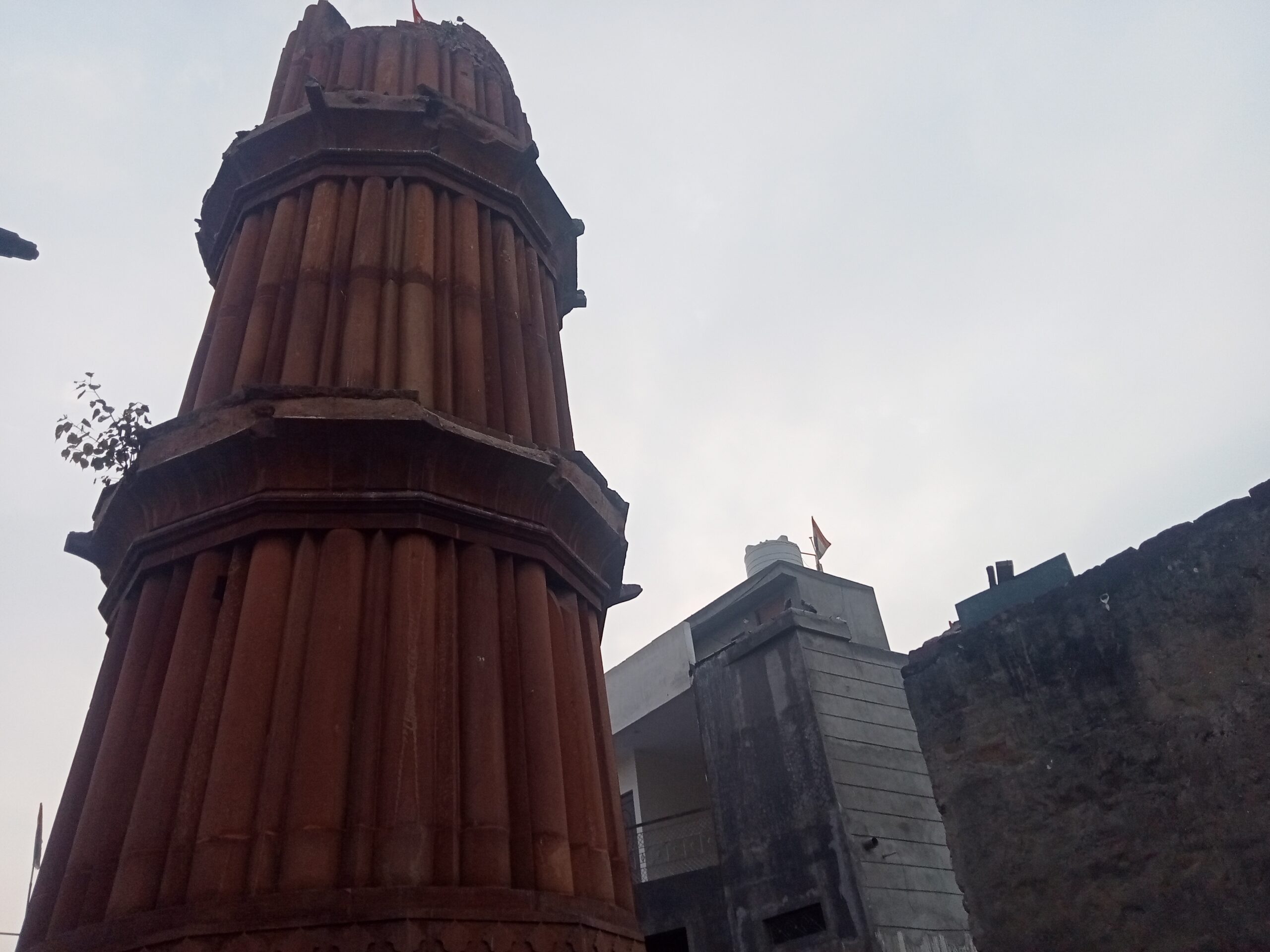
Shorter than most: Most houses in the nearby areas are taller than the minaret, hiding it from the view
Almost one kilometre from Uttam Nagar East metro station, at the corner of Hastsal village, stands a minaret which looks like a shorter version of the Qutub Minar.
If the Qutub Minar was abandoned half-way in the construction or was neglected to the point of obscurity, it would look somewhat like this.
Consequently, this 17-metre tower in west Delhi became popular as Mini Qutub Minar. Among the locals, it is also known as Hastsal Ki Laat and Kaushal Minar.
Legend has it that the Hastsal village area was once submerged in water and elephants used to rest here. The name ‘Hastsal’, made up of words haathi (elephant) and sthal (place) and meaning resting place of elephants, indicates this.
“I have lived here almost all my life. When I came here, the area was a forest but the minar was already there. With time, people started to build homes near the minar. No one visits it. In fact, I suppose nobody even knows about it. The only visitor here is the security guard,” says a woman in her early 50s while knitting a woollen sweater on a terrace near the minaret.
The minaret is hard to find, as it is packed between two-storey buildings, and looks unspectacular from a distance. However, as one takes a proper look, it reveals its connection with history. The exterior of the Mughal architecture is framed by an octagonal ring with red sandstone balconies (Chhajja), similar to those found in the Qutub Minar. It is built using Lakhori bricks.
Shah Jahan, the Mughal emperor, utilised Hastsal as one of his hunting lodges during the 17th century.
He ordered the building of this minaret in 1650. A staircase inside the five-storey tower led to the domed Chhatri pavilion at the top. A stunning hunting pavilion tower stood in the middle of a vast forest. After hunting in the nearby woods, the emperor relaxed at the tower’s top, entertained by his immediate retinue.
While many believe that it was much taller than it is now, some don’t. The locals have associated many legends with the shortness of the minar. Many in the area believe that the minaret was collapsed by an airplane that was passing by.
“We have grown up looking at this minaret. Our elders used to tell us that it was collapsed by an airplane. It filled us with wonder and fascination too,” says Tushar, a resident of the area, who is in his early twenties.
However, others call the airplane story a fabrication.
“Even my grandfather used to live in this area. There is nothing we can say about the shortness of this minaret. Yes, a lot of people believe that it was collapsed by an airplane, but neither does it make sense nor sound true. I have lived all my life, so I know for certain that it must not have been the case,” says another resident of the village, who is in his late 50s.
Due to frenzied construction activity in the area near the minaret, the entrance to the monument’s platform is narrow. A broken staircase leads to the half-metre wide alley surrounding its sides.
Some of the houses nearby are taller, making the minaret look insignificant. Yet the flight of pigeons from the terraces of kabootarbaaz in the area gives it a majestic appearance as the birds sit on it to rest – giving a feeling as if one is standing near a monument in old Delhi.
Mini Qutub Minar is the result of years of neglect and poor preservation. Many new constructions are taking place around the tower in Hastsal. Apart from the construction activities, the tower is also facing serious damage due to the environment. The lower platform near the minar has also been encroached by the new construction activities.
Maaz Rashid, an independent scholar who is researching on women and gender in Mughal India, says that these encroachments endanger the heritage of Delhi.
“Due to large scale population growth in Delhi, even the known heritage sites are in danger of encroachment. The lesser-known ones are even more vulnerable and on the verge of obscurity (or have completely been forgotten). These lesser-known sites are very important because they explain the gradual development and growth of Delhi and are not located in old Delhi or other popular areas, as is the case with Mini Qutub Minar. These sites include mosques, tombs, shrines and other monuments. Most of these sites are in a very bad condition. It becomes the duty of the government to protect these sites as they will be very useful in attracting tourists,” he says.
Residents in the area mostly come from working class families and the nearby states of Uttar Pradesh, Bihar and Rajasthan. Many work as mechanics, guards and labourers. Yet, a few hundred metres away, the demographic of the area changes as one can easily witness bigger and more spacious houses.
The concern of preserving the Mini Qutub Minar has been raised time and again. In 2018, the minaret was deemed as Grade A in heritage value and was given the permission to be conserved under Phase IV of Delhi government’s project to protect lesser-known monuments in the capital. The project also entailed conservation of the facade and preservation of the unique carvings on the mini tower.
Rival leagues trigger players’ suspensions and a legal battle in Indian golf, for now
Former Delhi CM Kejriwal criticises Centre, Delhi govt over worsening air pollution, alleges AQI manipulation
Delhi Police raids Nangloi unit producing fake engine oil, seizes over Rs 1 crore worth…
Mukesh Sharma reimagines digital components as living matter in his solo exhibition ‘Decoding Digital DNA’
Nine accused were arrested in coordinated raids as police uncovered organised networks supplying mule bank…
Nearly 1.57 lakh PUC challans issued in two months as Delhi steps up GRAP enforcement…